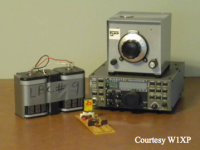 The Nashoba Valley Amateur Radio Club is continuing a neat tradition that encourages on-air activity by its members: the second annual NVARC Lantern Battery Challenge. This operating event begins at the end of the October meeting and runs until March 1, 2011. The goal is to contact as many stations as possible using a pack of lantern batteries as the sole power source. An entry fee is charged to cover the cost of the batteries. Complete rules and an entry blank will be available at the September NVARC meeting.
The Nashoba Valley Amateur Radio Club is continuing a neat tradition that encourages on-air activity by its members: the second annual NVARC Lantern Battery Challenge. This operating event begins at the end of the October meeting and runs until March 1, 2011. The goal is to contact as many stations as possible using a pack of lantern batteries as the sole power source. An entry fee is charged to cover the cost of the batteries. Complete rules and an entry blank will be available at the September NVARC meeting.
According to NVARC’s Bob Reif, W1XP, the Lantern Battery Challenge “is primarily a QRP event but the actual power is not specified.” There are several classes of entry, including: CW, SSB, digital, and mixed modes. Additionally, participants are restricted to using wire antennas or verticals no more than 50 feet in height. But, says Reif, “there is an unlimited category that you can compete in with your big antenna farm if you desire. The main purpose of this event is to have fun. And everyone that entered last year said they did.”
Participants operate for the event duration from October to March, or until his or her lantern battery is exhausted. They can run as much or little power as they wish, but all sending and receiving must be powered by the battery, comprised of ten lantern battery cells.
Logs will be due at the March meeting. Awards will be given out at the April NVARC meeting. Spreadsheets, computer logs or even paper logs on ARRL log book format are acceptable. A summery sheet is required and the exact form will be provided. QSLs are not required but verification by the judging committee is possible.
The idea is to have the period of operation cover the usually good HF conditions of fall and winter. All contacts must be made on the normal “contest” bands of 160, 80, 40, 20, 15, and 10 meters. Work any station only once per band, per mode.
Good luck in the “contest!”
–Thanks, Nashoba Valley ARC Signal, August 2010, Volume 19, Number 8

